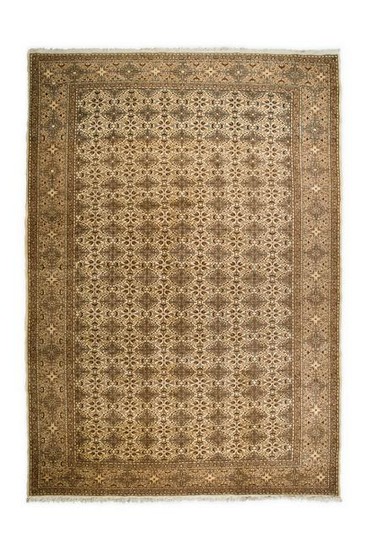Keysary Rug 291 x 202 cm
Kayseri 16318
Carpet No(Type N Reference):Â 16318
Origin (State, Province):Â Turkey
Size:Â 291 x 202 cm
Age:Â 3rd quarter of 20th century
Knots. 5 x 5 = 25 knots per sq cm
Condition . Excellent.
Category:Â Anatolian
Description of Design and History:
Antique Turkish Kayseri Rugs – The Turkish Kayseri rugs originate from the town of “Kayseri” which is located in central Turkey. The Turkish rugs from this town are commonly either made out of a combination of cotton and wool or out of pure silk. Because Kayseri was located on the silk trading rout, many of the influences on the rugs’ designs and patterns come from Iran and other regions that Kayseri traded with.
Carpet weaving has been a very important practice in Kayseri for centuries, a tradition that has been passed on through families to this day. Usually these Oriental rugs were woven by a group of women who would pool their skills together in order to handmake these masterpieces. These rugs were very popular among the Turkish middle and upper-class for the past several centuries and continue to be popular both in Turkey and internationally today.
The wool rugs are usually made of hand-spun wool and were traditionally colored using natural carpet dyes. Antique Turkish Kayseri rugs are unique in design, even among Turkish rugs, and are easily told apart from the antique rugs that were made in other towns. The silk rugs of Kayseri, in particular, are famous for their intricate designs, soft texture and fine weaving. These silk rugs are usually not always used on the floor, but instead, due to their artistic beauty, many be used to cover tables or even used as wall hangings. In terms of design, the Turkish Kayseri rugs tend to be on the more formal end and often will employ a floral motif.All natural dyes are paramount for the carpet to have more than just decorative value. Beyond that, various dyers had varying levels of skill and invested different lengths of time in dyeing the yarns. The “quality of color”–its radiance and level of nuance within each color–is centrally important. Certain rare colors such as Tyrian purple, saffron yellow, cochineal rose and greens add to the carpet’s value
Condition Report: The absence of a condition report does not imply that the lot is in perfect condition. Please carefully read our terms of sale, shipping pick up & payment information. We are happy and willing to answer questions about any of our lots as well as to send additional images. It is the responsibility of the bidder to pose any questions BEFORE bidding. Please email us for a shipping quote if needed. All sales are final.
View it on
Estimate
Time, Location
Auction House
Kayseri 16318
Carpet No(Type N Reference):Â 16318
Origin (State, Province):Â Turkey
Size:Â 291 x 202 cm
Age:Â 3rd quarter of 20th century
Knots. 5 x 5 = 25 knots per sq cm
Condition . Excellent.
Category:Â Anatolian
Description of Design and History:
Antique Turkish Kayseri Rugs – The Turkish Kayseri rugs originate from the town of “Kayseri” which is located in central Turkey. The Turkish rugs from this town are commonly either made out of a combination of cotton and wool or out of pure silk. Because Kayseri was located on the silk trading rout, many of the influences on the rugs’ designs and patterns come from Iran and other regions that Kayseri traded with.
Carpet weaving has been a very important practice in Kayseri for centuries, a tradition that has been passed on through families to this day. Usually these Oriental rugs were woven by a group of women who would pool their skills together in order to handmake these masterpieces. These rugs were very popular among the Turkish middle and upper-class for the past several centuries and continue to be popular both in Turkey and internationally today.
The wool rugs are usually made of hand-spun wool and were traditionally colored using natural carpet dyes. Antique Turkish Kayseri rugs are unique in design, even among Turkish rugs, and are easily told apart from the antique rugs that were made in other towns. The silk rugs of Kayseri, in particular, are famous for their intricate designs, soft texture and fine weaving. These silk rugs are usually not always used on the floor, but instead, due to their artistic beauty, many be used to cover tables or even used as wall hangings. In terms of design, the Turkish Kayseri rugs tend to be on the more formal end and often will employ a floral motif.All natural dyes are paramount for the carpet to have more than just decorative value. Beyond that, various dyers had varying levels of skill and invested different lengths of time in dyeing the yarns. The “quality of color”–its radiance and level of nuance within each color–is centrally important. Certain rare colors such as Tyrian purple, saffron yellow, cochineal rose and greens add to the carpet’s value
Condition Report: The absence of a condition report does not imply that the lot is in perfect condition. Please carefully read our terms of sale, shipping pick up & payment information. We are happy and willing to answer questions about any of our lots as well as to send additional images. It is the responsibility of the bidder to pose any questions BEFORE bidding. Please email us for a shipping quote if needed. All sales are final.



